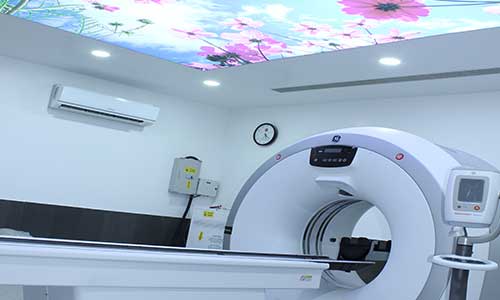 Radio Diagnosis
Radio Diagnosis
The Diagnostic Imaging Department of JJIMS is located on the 2ND BASEMENT of the hospital. We provide a diverse range of radiographic services and modern equipment
-
General Radiography
This examination uses X-rays to image virtually any body part like a photograph. The X-rays pass through the body and is captured on a film. The equipment may be static or mobile, allowing X-rays to be done by the bedside. WE HAVE 600 MA ADVANCED digital Radiography and CR system beside 3 portable X-Rays for intensive care areas for on site X-Ray with moving a patient out of the bed. There are 2 mobile X-Ray units (C-ARM Systems) within our OT complex to assist complex surgical procedures.
-
Ultrasound Examination

- Ultrasound is a technique of imaging that uses high frequency sound waves to produce an image of the internal organs and structures of the body. It uses no X-rays. We have latest highend $D colored USG with all advanced cardiac and trans Vaginal probe and smaller probes especially designed for kids and small body parts.
-
Computed Tomography Scan (C.T. Scan)

- C.T. Scan provides an excellent anatomical examination to obtain a comprehensive cross-sectional image of the body, such as head, chest, abdomen and spine. A C.T. scan is an X-ray procedure enhanced by a computer. This results in a two- or three-dimensional view (referred to as a slice or a cross-section) of a particular part of the body.
-
Fluoroscopy
Fluoroscopy is a mode of imaging any part or organ of the body in a moving form. A continuous X-ray beam is passed through the body part being examined, and is transmitted to a TV-like monitor so that the body part and its motion can be seen in detail. The images can be captured on hard copies.
-
Angiography
Angiography is the study of blood vessels which involves the injection of a radio-opaque 'dye' into a vessel via a specially shaped tube called a catheter, and taking X-ray images in rapid succession. Abnormal vessels and tumours can be studied this way. Abnormally formed vessels (malformation) such as stenotic vessels and aneurysms are some of the examples of blood vessel diseases.
-
Non-vascular Interventional Radiology
Non-vascular interventional radiology has come to play an increasingly important part in the day-to-day work of the department. This trend is expected to continue with current developments in patient management. It is a "minimally invasive technique" that involves the treatment of conditions such as drainage of abscess, blocked urinary system and biliary tracts. The radiologists perform these procedures using X-rays, ultrasound or C.T. to guide them.
Copyright © 2025 J.J.Institute of Medical Sciences All Rights Reserved.






